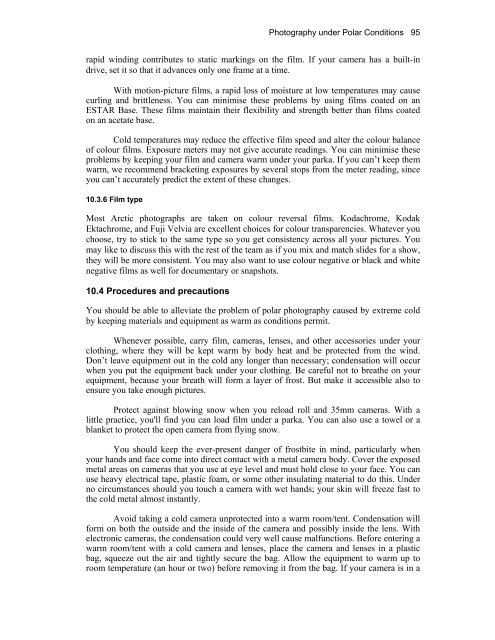Edited by Rachel Duncan 4th Edition ISBN 0-907649-91-2 London ...
Edited by Rachel Duncan 4th Edition ISBN 0-907649-91-2 London ...
Edited by Rachel Duncan 4th Edition ISBN 0-907649-91-2 London ...
Create successful ePaper yourself
Turn your PDF publications into a flip-book with our unique Google optimized e-Paper software.
Photography under Polar Conditions 95<br />
rapid winding contributes to static markings on the film. If your camera has a built-in<br />
drive, set it so that it advances only one frame at a time.<br />
With motion-picture films, a rapid loss of moisture at low temperatures may cause<br />
curling and brittleness. You can minimise these problems <strong>by</strong> using films coated on an<br />
ESTAR Base. These films maintain their flexibility and strength better than films coated<br />
on an acetate base.<br />
Cold temperatures may reduce the effective film speed and alter the colour balance<br />
of colour films. Exposure meters may not give accurate readings. You can minimise these<br />
problems <strong>by</strong> keeping your film and camera warm under your parka. If you can’t keep them<br />
warm, we recommend bracketing exposures <strong>by</strong> several stops from the meter reading, since<br />
you can’t accurately predict the extent of these changes.<br />
10.3.6 Film type<br />
Most Arctic photographs are taken on colour reversal films. Kodachrome, Kodak<br />
Ektachrome, and Fuji Velvia are excellent choices for colour transparencies. Whatever you<br />
choose, try to stick to the same type so you get consistency across all your pictures. You<br />
may like to discuss this with the rest of the team as if you mix and match slides for a show,<br />
they will be more consistent. You may also want to use colour negative or black and white<br />
negative films as well for documentary or snapshots.<br />
10.4 Procedures and precautions<br />
You should be able to alleviate the problem of polar photography caused <strong>by</strong> extreme cold<br />
<strong>by</strong> keeping materials and equipment as warm as conditions permit.<br />
Whenever possible, carry film, cameras, lenses, and other accessories under your<br />
clothing, where they will be kept warm <strong>by</strong> body heat and be protected from the wind.<br />
Don’t leave equipment out in the cold any longer than necessary; condensation will occur<br />
when you put the equipment back under your clothing. Be careful not to breathe on your<br />
equipment, because your breath will form a layer of frost. But make it accessible also to<br />
ensure you take enough pictures.<br />
Protect against blowing snow when you reload roll and 35mm cameras. With a<br />
little practice, you'll find you can load film under a parka. You can also use a towel or a<br />
blanket to protect the open camera from flying snow.<br />
You should keep the ever-present danger of frostbite in mind, particularly when<br />
your hands and face come into direct contact with a metal camera body. Cover the exposed<br />
metal areas on cameras that you use at eye level and must hold close to your face. You can<br />
use heavy electrical tape, plastic foam, or some other insulating material to do this. Under<br />
no circumstances should you touch a camera with wet hands; your skin will freeze fast to<br />
the cold metal almost instantly.<br />
Avoid taking a cold camera unprotected into a warm room/tent. Condensation will<br />
form on both the outside and the inside of the camera and possibly inside the lens. With<br />
electronic cameras, the condensation could very well cause malfunctions. Before entering a<br />
warm room/tent with a cold camera and lenses, place the camera and lenses in a plastic<br />
bag, squeeze out the air and tightly secure the bag. Allow the equipment to warm up to<br />
room temperature (an hour or two) before removing it from the bag. If your camera is in a

















